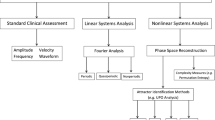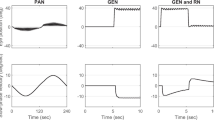Abstract
The significance of a nystagmus-dependent, transient component in the overall slow-phase response of the vestibulo-ocular reflex (VOR) is brought into focus. First, a simulated example is presented that shows how this transient component can bias current algorithms for the estimation of VOR parameters. Second, new algorithms are proposed that are able to estimate VOR parameters regardless of the presence of transients. Third, the new algorithms are applied to experimental data, and the results are compared with those from current algorithms. The results clearly show that the transient component can significantly alter the apparent VOR time constant, particularly when the reflex has been lesioned. The algorithms open new areas of research on the possible role of nystagmus in enhancing the compensatory function of the VOR.
Similar content being viewed by others
References
Baker RC, Evinger C, McCrea RA (1981) Some thoughts about the three neurons in the vestibuloocular reflex. In: Cohen B (ed) Vestibular and oculomotor physiology (Part IV). Ann N Y Acad Sci 374:171–188
Barnes GR (1980) Vestibular control of oculomotor and postural mechanisms. Clin Phys Physiol Meas 1:3–40
Barnes GR (1982) A procedure for the analysis of nystagmus and other eye movements. Aviat Space Environ Med 53:676–682
Caines PE (1988) Linear stochastic systems. Wiley, Toronto
Cannon SC, Robinson DA (1987) Loss of the neural integrator of the oculomotor system from brainstem lesions in monkey. J Neurophysiol 57:1383–1409
Cheron G, Godaux E (1987) Disabling of the oculomotor neural integrator by kainic acid injections in the prepositus-vestibular complex of the cat. J Physiol (Lond) 372:267–290
Cheron G, Godaux E, Laune JM, Vanerkelen B (1986) Lesions in the cat prepositus complex: effects on the vestibuloocular reflex and saccades. J Physiol (Lond) 372:75–94
Devore JL (1982) Probability and statistics for engineering and the sciences. Brooks/Cole, Monterey, Calif
Franklin GF, Powell JD (1981) Digital control of dynamic systems. Addison-Wesley, Reading, Mass
Galiana HL, Outerbridge JS (1984) A bilateral model for central neural pathways in vestibuloocular reflex. J Neurophysiol 51:210–241
Galiana HL (1986) Slow phase velocity storage: a reflection of asymmetry in central bilateral responses during nystagmus? In: Abstracts Satellite Meeting on Developments on Oculomotor Research, Salishan, Oregon, July 20–24
Galiana HL (1991) A nystagmus strategy to linearize the vestibulo-ocular reflex. IEEE Trans Biomed Eng 38(6):532–543
Kaneko CRS (1992) Effects of ibotenic acid lesions of nucleus prepositus hypoglossi on optokinetic and vestibular eye movements in the alert, trained monkey. Ann N Y Acad Sci 656:408–427
Katsarkas A, Outerbridge JS (1981) Compensation of unilateral loss in vestibular neuronitis. Ann N Y Acad Sci 374:784–793
Katsarkas A, Galiana HL, Smith H (1991) Does the vestibulo-ocular reflex (VOR) merit redefinition? Otolaryngol Head Neck Surg 105(5):633–640
Lisberger SG, Miles FA, Zee DS (1984) Signals used to compute errors in monkey vestibuloocular reflex: possible role of the flocculus. J Neurophysiol 52:1140–1153
Ljung L (1986) System identification for the user. Prentice Hall, Englewood Cliffs, NJ
Outerbridge JS (1969) Experimental and theoretical investigation of vestibularly driven head and eye movement. PhD thesis, McGill University, Montreal
Raphan T, Matsuo V, Cohen B (1979) Velocity storage in the vestibuloocular reflex arc (VOR). Exp Brain Res 35:229–248
Rey CG (1992) New algorithms for the classification and identification of the vestibulo-ocular reflex. PhD thesis, McGill University, Montreal
Rey CG, Galiana HL (1991a) Parametric classification of segments in ocular nystagmus. IEEE Trans Biomed Eng 38(2):142–148
Rey CG, Galiana HL (1991b) Identification of the VOR. In: Proc 17th Canadian Medical and Biological Engineering Society Conference, Banff, Alberta, May 7–11th, pp 121–122
Robinson DA (1981) The use of control systems analysis in the neurophysiology of eye movements. Annu Rev Neurosci 4:463–503
Schmidt RM, Stefanelli M, Mira E (1971) Mathematical modelling of a contribution to clinical vestibular nystagmus. Acta Otolaryngol 72:292–302
Schmid R, Zambarbieri D (1991) Eye-head coordination during active and passive head rotation in the dark. In: Berthoz A, Vidal PP, Graf W (eds) Head-neck sensory motor system. Oxford University Press, Oxford, pp 434–438
Söderström T, Stoica P (1987) System identification. Prentice Hall, Englewood Cliffs, NJ
Straube A, Kurzan R, Büttner U (1991) Differential effects of bicuculline and muscimol microinjections into the vestibular nuclei on simian eye movements. Exp Brain Res 86:347–358
Sugie N, Melvill Jones G (1971) A model of eye movements induced by head rotation. IEEE Trans Systems, Man and Cybern SMC-1:251–260
Vijayan R, Poor HV, Moore JB, Goodwin GC (1991) A Levinson type algorithm for modeling fast sampled data. IEEE Trans Autom Control 36(3):314–321
Wall C III, Black FO (1981) Algorithms for the clinical analysis of nystagmus eye movements. IEEE Trans Biomed Eng 28:638–646
Wall C III, Black FO, O'Leary DP (1978) Clinical use of pseudorandom binary sequence white noise in assessment of the human vestibulo-ocular system. Ann Otol Rhinol Laryngol 87:845–852
Author information
Authors and Affiliations
Rights and permissions
About this article
Cite this article
Rey, C.G., Galiana, H.L. Transient analysis of vestibular nystagmus. Biol. Cybern. 69, 395–405 (1993). https://doi.org/10.1007/BF01185411
Received:
Accepted:
Issue Date:
DOI: https://doi.org/10.1007/BF01185411




